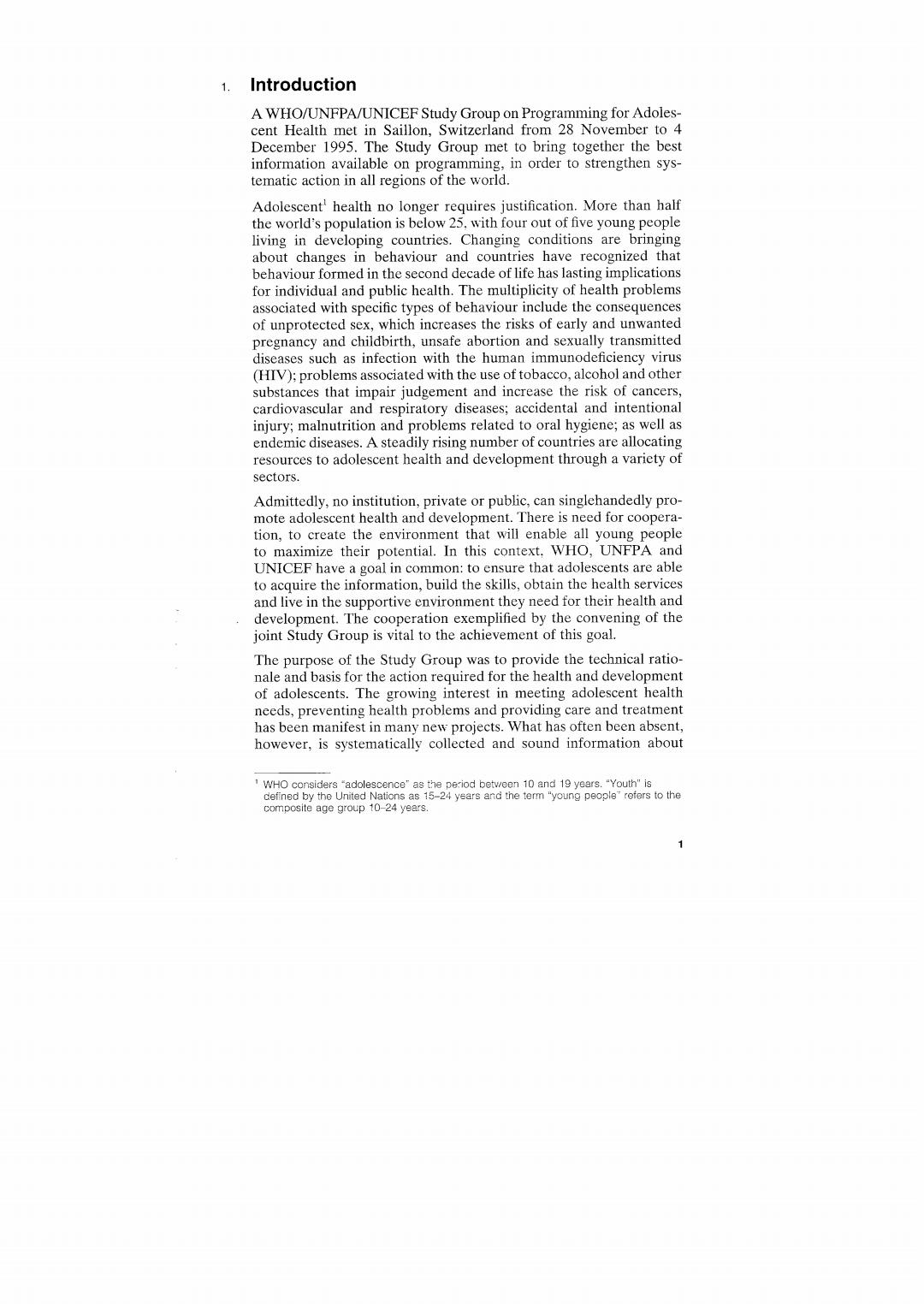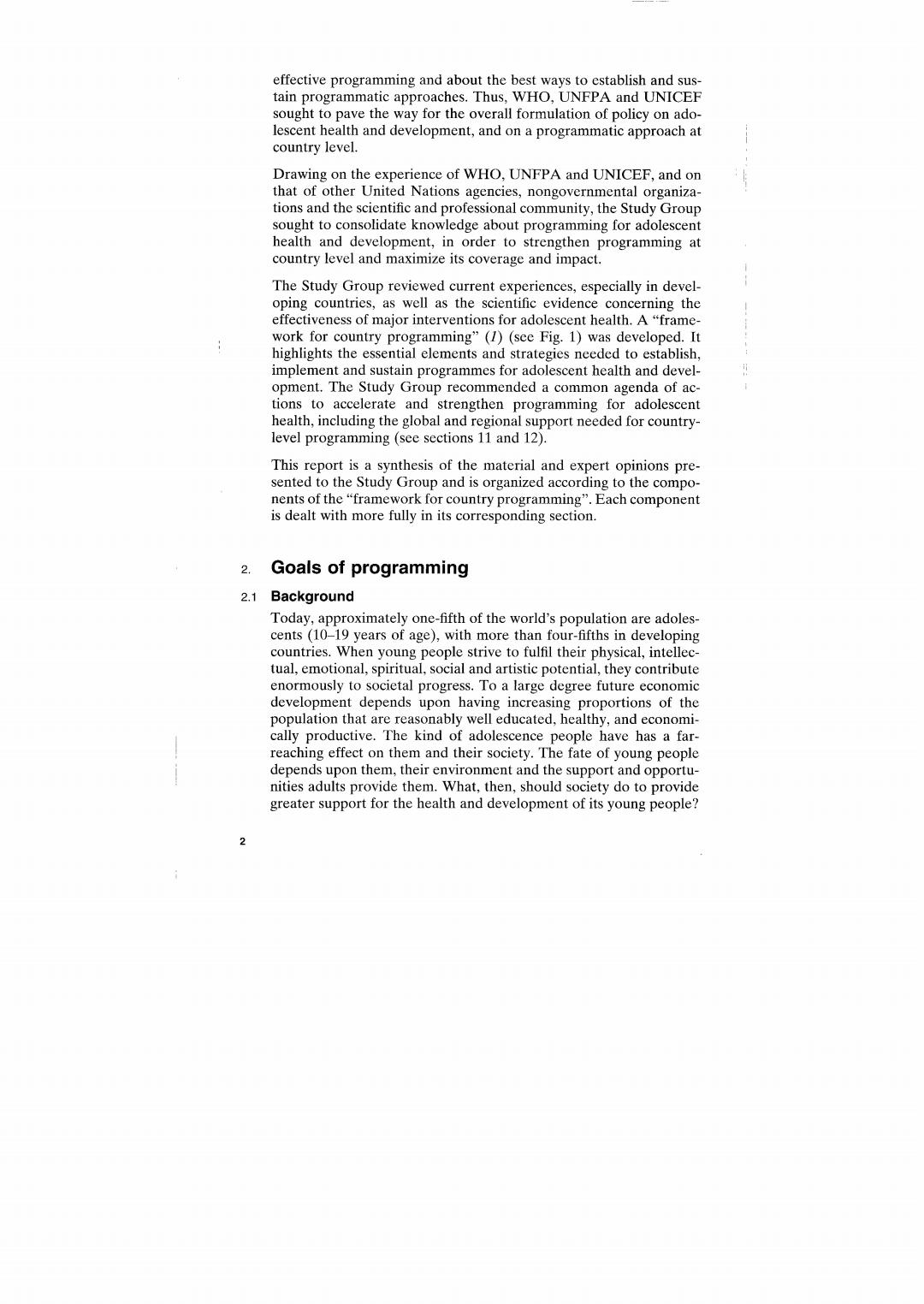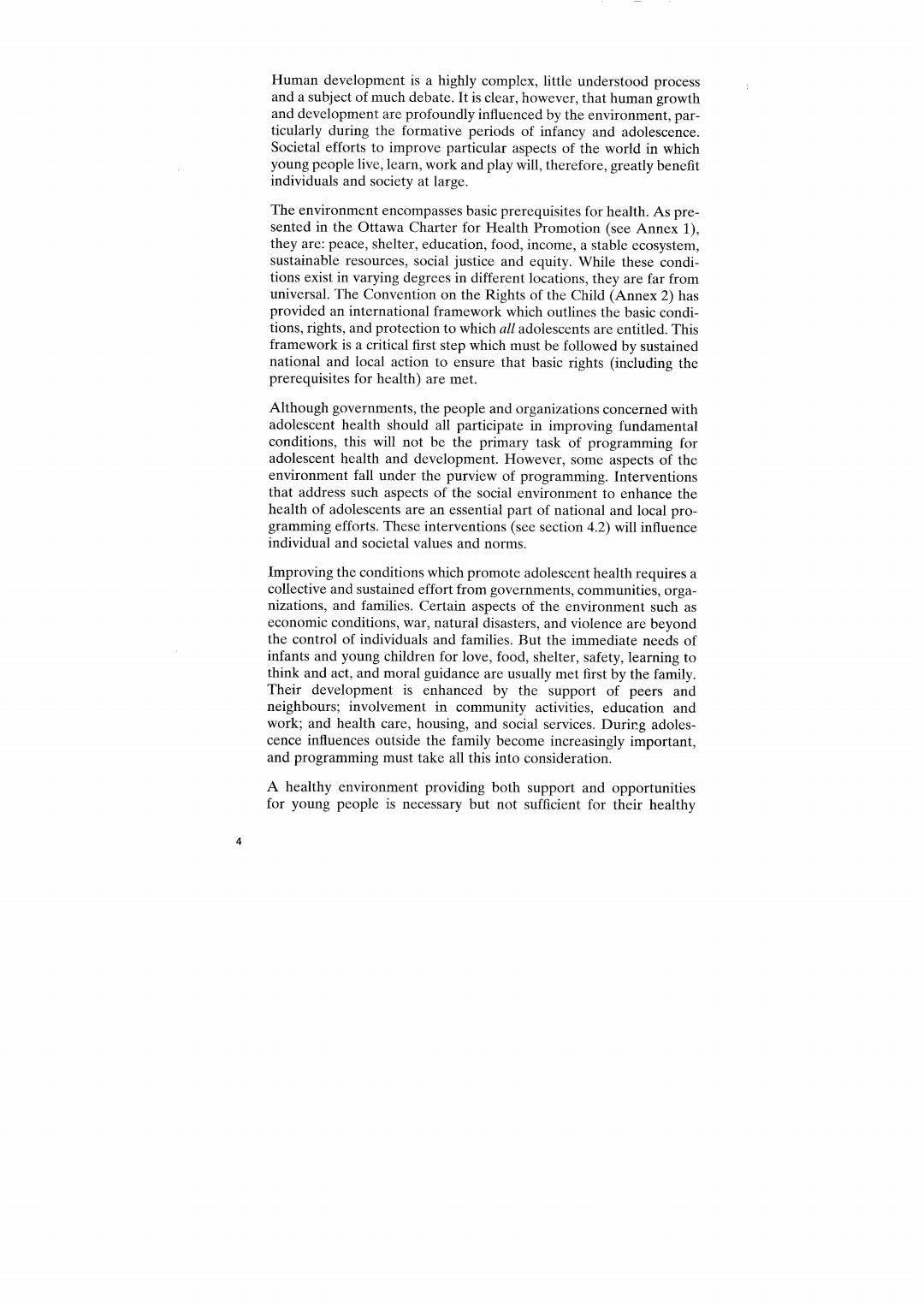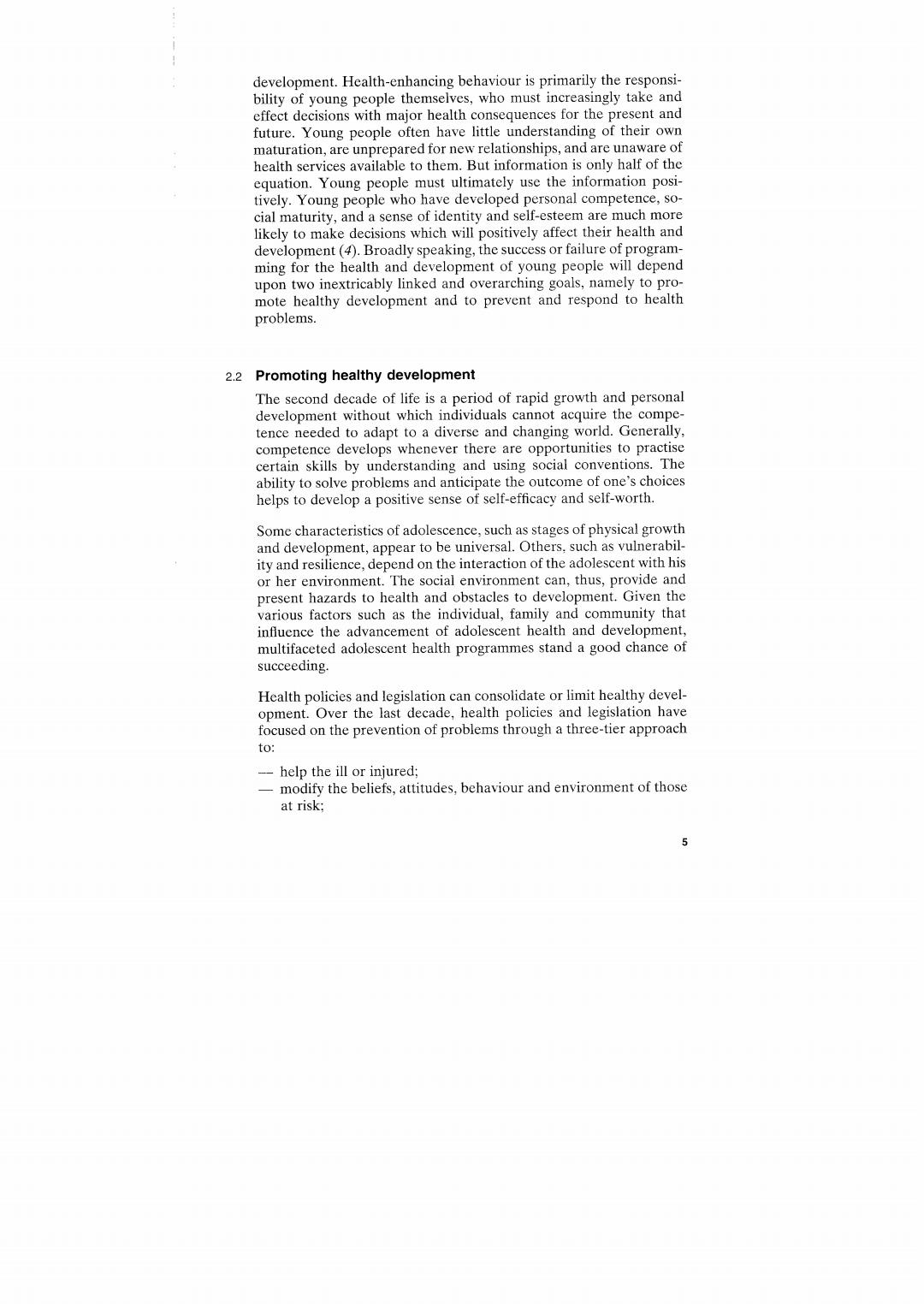
1.Introduction A WHO/UNFPA/UNICEF Study Group on Programming for Adoles- cent Health met in Saillon,Switzerland from 28 November to 4 December 1995.The Study Group met to bring together the best information available on programming,in order to strengthen sys- tematic action in all regions of the world. Adolescent'health no longer requires justification.More than half the world's population is below 25,with four out of five young people living in developing countries.Changing conditions are bringing about changes in behaviour and countries have recognized that behaviour formed in the second decade of life has lasting implications for individual and public health.The multiplicity of health problems associated with specific types of behaviour include the consequences of unprotected sex,which increases the risks of early and unwanted pregnancy and childbirth,unsafe abortion and sexually transmitted diseases such as infection with the human immunodeficiency virus (HIV);problems associated with the use of tobacco,alcohol and other substances that impair judgement and increase the risk of cancers, cardiovascular and respiratory diseases;accidental and intentional injury;malnutrition and problems related to oral hygiene;as well as endemic diseases.A steadily rising number of countries are allocating resources to adolescent health and development through a variety of sectors. Admittedly,no institution,private or public,can singlehandedly pro- mote adolescent health and development.There is need for coopera- tion,to create the environment that will enable all young people to maximize their potential.In this context,WHO,UNFPA and UNICEF have a goal in common:to ensure that adolescents are able to acquire the information,build the skills,obtain the health services and live in the supportive environment they need for their health and development.The cooperation exemplified by the convening of the joint Study Group is vital to the achievement of this goal. The purpose of the Study Group was to provide the technical ratio- nale and basis for the action required for the health and development of adolescents.The growing interest in meeting adolescent health needs,preventing health problems and providing care and treatment has been manifest in many new projects.What has often been absent, however,is systematically collected and sound information about WHO considers "adolescence"as the period between 10 and 19 years."Youth"is defined by the United Nations as 15-24 years and the term"young people"refers to the composite age group -24 years

effective programming and about the best ways to establish and sus- tain programmatic approaches.Thus,WHO,UNFPA and UNICEF sought to pave the way for the overall formulation of policy on ado- lescent health and development,and on a programmatic approach at country level. Drawing on the experience of WHO,UNFPA and UNICEF,and on that of other United Nations agencies,nongovernmental organiza- tions and the scientific and professional community,the Study Group sought to consolidate knowledge about programming for adolescent health and development,in order to strengthen programming at country level and maximize its coverage and impact. The Study Group reviewed current experiences,especially in devel- oping countries,as well as the scientific evidence concerning the effectiveness of major interventions for adolescent health.A "frame- work for country programming"(1)(see Fig.1)was developed.It highlights the essential elements and strategies needed to establish, implement and sustain programmes for adolescent health and devel- opment.The Study Group recommended a common agenda of ac- tions to accelerate and strengthen programming for adolescent health,including the global and regional support needed for country- level programming(see sections 11 and 12). This report is a synthesis of the material and expert opinions pre- sented to the Study Group and is organized according to the compo- nents of the"framework for country programming".Each component is dealt with more fully in its corresponding section. 2. Goals of programming 2.1 Background Today,approximately one-fifth of the world's population are adoles- cents (10-19 years of age),with more than four-fifths in developing countries.When young people strive to fulfil their physical,intellec- tual,emotional,spiritual,social and artistic potential,they contribute enormously to societal progress.To a large degree future economic development depends upon having increasing proportions of the population that are reasonably well educated,healthy,and economi- cally productive.The kind of adolescence people have has a far- reaching effect on them and their society.The fate of young people depends upon them,their environment and the support and opportu- nities adults provide them.What,then,should society do to provide greater support for the health and development of its young people?

a ebBJeNoo pue Killenb youn. sseoons o]sAay pue juaneud o1 uagdoftrlpesn plng pue sabualleyo eoounBpewuPueOuAlcuEluCgieeeoessaihn ioe ol ejq

Human development is a highly complex,little understood process and a subject of much debate.It is clear,however,that human growth and development are profoundly influenced by the environment,par- ticularly during the formative periods of infancy and adolescence Societal efforts to improve particular aspects of the world in which young people live,learn,work and play will,therefore,greatly benefit individuals and society at large. The environment encompasses basic prerequisites for health.As pre- sented in the Ottawa Charter for Health Promotion (see Annex 1), they are:peace,shelter,education,food,income,a stable ecosystem. sustainable resources,social justice and equity.While these condi- tions exist in varying degrees in different locations,they are far from universal.The Convention on the Rights of the Child (Annex 2)has provided an international framework which outlines the basic condi- tions,rights,and protection to which all adolescents are entitled.This framework is a critical first step which must be followed by sustained national and local action to ensure that basic rights (including the prerequisites for health)are met. Although governments,the people and organizations concerned with adolescent health should all participate in improving fundamental conditions,this will not be the primary task of programming for adolescent health and development.However,some aspects of the environment fall under the purview of programming.Interventions that address such aspects of the social environment to enhance the health of adolescents are an essential part of national and local pro- gramming efforts.These interventions (see section 4.2)will influence individual and societal values and norms. Improving the conditions which promote adolescent health requires a collective and sustained effort from governments,communities,orga- nizations,and families.Certain aspects of the environment such as economic conditions,war,natural disasters,and violence are beyond the control of individuals and families.But the immediate needs of infants and young children for love,food,shelter,safety,learning to think and act,and moral guidance are usually met first by the family Their development is enhanced by the support of peers and neighbours;involvement in community activities,education and work;and health care,housing,and social services.Durirg adoles- cence influences outside the family become increasingly important, and programming must take all this into consideration. A healthy environment providing both support and opportunities for young people is necessary but not sufficient for their healthy

development.Health-enhancing behaviour is primarily the responsi- bility of young people themselves,who must increasingly take and effect decisions with major health consequences for the present and future.Young people often have little understanding of their own maturation,are unprepared for new relationships,and are unaware of health services available to them.But information is only half of the equation.Young people must ultimately use the information posi- tively.Young people who have developed personal competence,so- cial maturity,and a sense of identity and self-esteem are much more likely to make decisions which will positively affect their health and development(4).Broadly speaking,the success or failure of program- ming for the health and development of young people will depend upon two inextricably linked and overarching goals,namely to pro- mote healthy development and to prevent and respond to health problems. 2.2 Promoting healthy development The second decade of life is a period of rapid growth and personal development without which individuals cannot acquire the compe- tence needed to adapt to a diverse and changing world.Generally. competence develops whenever there are opportunities to practise certain skills by understanding and using social conventions.The ability to solve problems and anticipate the outcome of one's choices helps to develop a positive sense of self-efficacy and self-worth. Some characteristics of adolescence,such as stages of physical growth and development,appear to be universal.Others,such as vulnerabil- ity and resilience,depend on the interaction of the adolescent with his or her environment.The social environment can,thus,provide and present hazards to health and obstacles to development.Given the various factors such as the individual,family and community that influence the advancement of adolescent health and development, multifaceted adolescent health programmes stand a good chance of succeeding. Health policies and legislation can consolidate or limit healthy devel- opment.Over the last decade,health policies and legislation have focused on the prevention of problems through a three-tier approach to: -help the ill or injured; modify the beliefs,attitudes,behaviour and environment of those at risk: